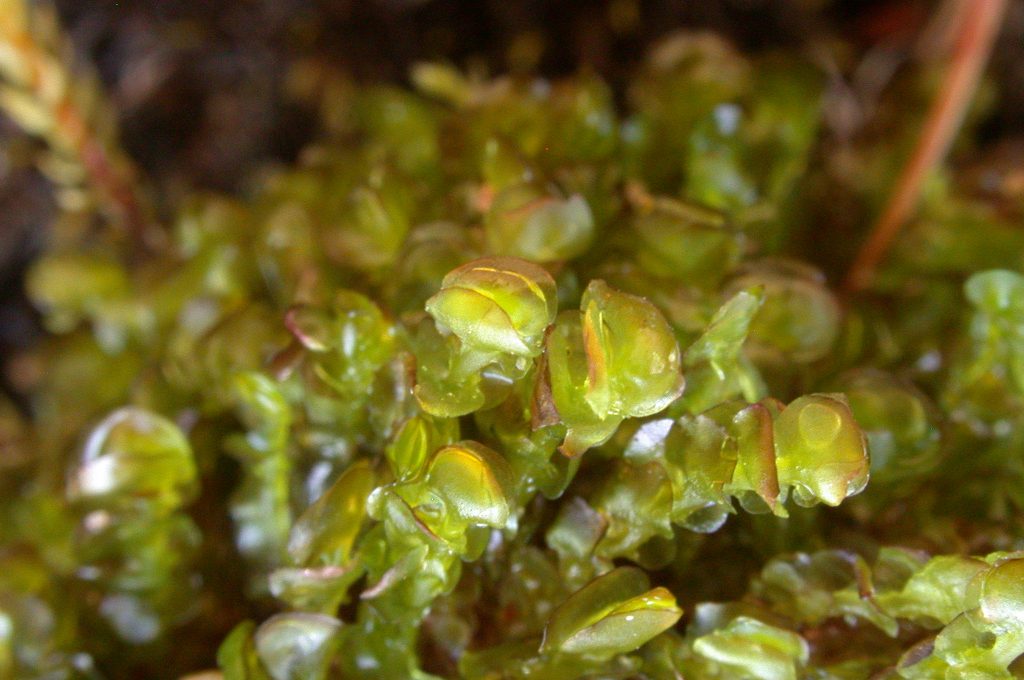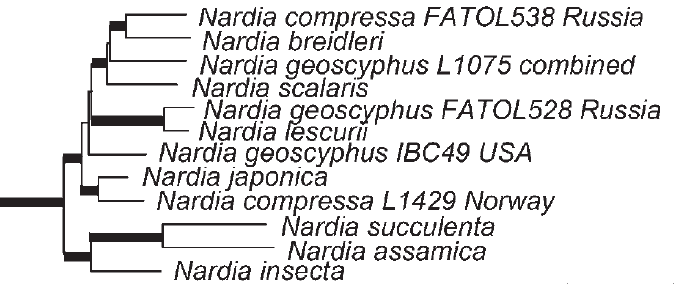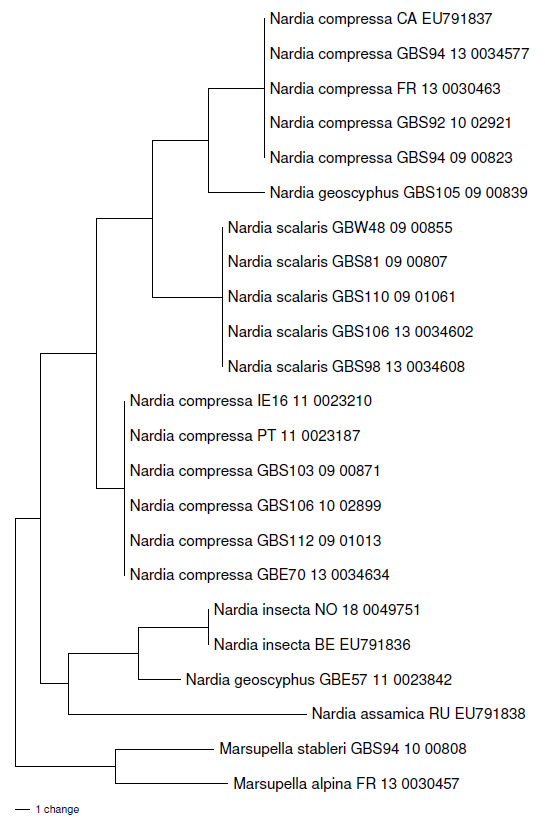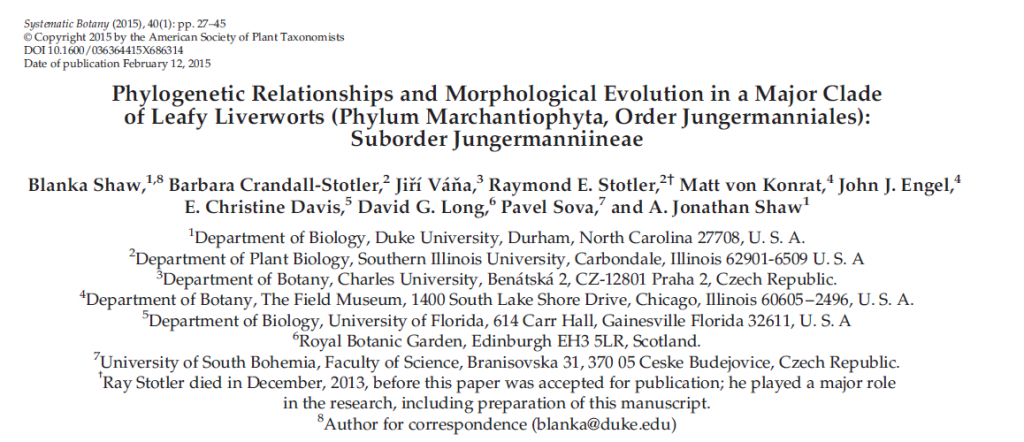The leafy liverwort genus Nardia has five species that are known to occur in Scotland.

Nardia compressa, from Scotland, vice county 94, Long 36956 (E), photographed by David Long (EDNA09-00823)
Of these five species that occur in Scotland, four are described in Smith’s “The liverworts of Britain and Ireland” (1990), and are also treated in the British Bryological Society’s “Mosses and Liverworts of Britain and Ireland: a field guide” (2010):
Nardia scalaris (Schrad.) Gray: “Usually on damp, acidic, mineral soil subject to disturbance, where it can form extensive, thin mats. Most common on banks by gravel tracks, in quarries and cuttings for forest roads, on fine scree and forming dense cushions in areas of late lying snow. It can also occur on river gravels and on rocks in similar places to N. compressa” (Gordon Rothero, p. 152);
Nardia compressa (Hook.) Gray: “Grows in permanently wet or frequently inundated, acidic places on rocks and stones in turbulent streams and rivers, and occasionally embedded in sand and gravel. N. compressa most typically forms spongy masses in cold, slow-flowing headwaters of upland streams. In burns and flushes associated with very late-lying snow, it can form pure patches covering many square metres” (Gordon Rothero, p. 151);
Nardia breidleri (Limpr.) Lindb.: “A plant of shallow, stony soils where snow lies late in the year, or gravelly terraces on exposed ridges high in the mountains, and usually found in a crust of other liverwort species, especially Marsupella brevissima” (Gordon Rothero, p. 154). IUCN red-list category: near-threatened;
Nardia geoscyphus (De Not.) Lindb.: “rather an unpredictable species, and is seldom present in abundance. It is most frequent on mildly base-rich soil banks in the uplands (for example on calcareous cliffs), but sometimes grows on damp, gravelly soil in disused quarries” (Gordon Rothero, p. 153);
Nardia insecta Lindb.: “a very rare plant” (Gordon Rothero, p. 153), with similarities to Nardia geoscyphus. IUCN red-list category: vulnerable.
Worldwide, there are an additional 21 accepted (and six unresolved) species names in Tropicos.
The best DNA sequence sampling of the genus is in a phylogeny of the Jungermanniineae published by Shaw et al. (2015), which includes exemplars of the five species present in Scotland. Their study includes a total of 12 accessions of Nardia, comprising nine named species. Both of the species for which more than a single accession has been sampled, Nardia compressa (with accessions from Russia and Norway) and Nardia geoscyphus (with one accession from Russia and two from the US, one with no cited state location, the other, L1075, from Alaska), are not monophyletic, but are scattered polyphyletically throughout the genus.

Nardia phylogeny adapted from Shaw et al. 2015, based on sequences generated from one nuclear (rpb2), two mitochondrial (nad1 and rps3), and seven plastid (atpB, psbA, psbT-H, rbcL, rps4, trnG and trnL) loci
This certainly serves as a very strong indication that there are issues with species identification and delimitation within Nardia!
So what’s the picture for Nardia using our bryophyte DNA barcoding data? This mostly focuses on accessions from the British Isles. We have sequence data for two accessions of Nardia geoscyphus, five of Nardia scalaris, and ten of Nardia compressa. We have also sequenced a Norwegian accession of Nardia insecta, and have been able to add three further ITS sequences from the NCBI database, GenBank, as well. Unfortunately we do not yet have any sequence data from Nardia breidleri.
The data we have shows that the two accessions of Nardia geoscyphus, from England (GBE) and Scotland (GBS), are genetically distinct. Likewise, Nardia compressa falls into two separate clades, one with accessions from Scotland (including the accession in the photograph above), Canada (CA) and France (FR), and the other with accessions from Scotland, England, Ireland (IE) and Portugal (PT).

Maximum parsimony phylogram for Nardia, based on nr ITS sequence data, with country code and vice-county number following the species name, rooted on Marsupella
It’s clear that there’s more going on with Nardia than we currently recognise. Two of our commoner Nardia species require taxonomic revision, as they encompass more than one distinct entity – as things stand, we are overestimating the abundance of these species. If we can find morphological characters that we could use to distinguish them in the field and in the herbarium, we would gain a far clearer picture of their distributions and of their rarity.
Acknowledgements: some of the molecular work on this project has been done by Dr Michelle Hart, Ruth Hollands and Alex Clark. Dr Kristian Hassel from the NTNU University Museum in Trondheim has kindly sent us Norwegian samples of the two British red-listed species, Nardia breidleri and Nardia insecta.
Further reading:
Vadim A. Bakalin. 2012. Nardia hiroshii Amakawa – A new species for North American liverwort flora and the key to Nardia species in North Pacific. Arctoa 21: 97-100

